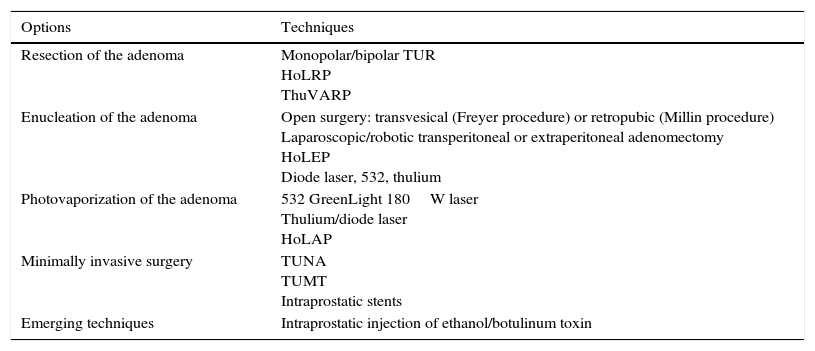The treatment of benign prostatic hyperplasia (BPH) is changing due to a greater understanding of the disease and the development of the functional concept of lower urinary tract symptoms (LUTS).
ObjectivesTo describe the current state of BPH and the diagnosis and treatment of LUTS.
Acquisition of evidenceWe summarize the issues presented and debated by a group of expert urologists during the First UROVI Congress, sponsored by the Spanish Urological Association.
Summary of the evidenceLUTS encompasses filling, voiding and postvoiding symptoms that affect patients’ quality of life. The aetiological diagnosis is an important element in starting the most ideal treatment. For this reason, new alternative therapies (both pharmacological and surgical) are needed to help individually address the symptoms in the various patient profiles. There is now a new combination of drugs (6mg of solifenacin and 0.4mg of the tamsulosin oral controlled absorption system) for treating moderate to severe filling symptoms and emptying symptoms associated with BPH in patients who do not respond to monotherapy. Furthermore, new surgical techniques that are increasingly less invasive help provide surgical options for older patients and those with high comorbidity.
ConclusionsThe availability of drugs that can act on the various LUTS helps integrate the pathophysiological paradigm into the functional one, providing more appropriate treatment for our patients.
El tratamiento de la hiperplasia benigna de próstata (HBP) está cambiando debido a un mayor conocimiento de la enfermedad y al desarrollo del concepto funcional de los síntomas del tracto urinario inferior (STUI).
ObjetivosExponer la situación actual en el ámbito de la HBP incluyendo el diagnóstico y tratamiento de los STUI.
Adquisición de la evidenciaSe resumen los temas presentados y debatidos por un grupo de urólogos expertos durante el i Congreso UROVI, auspiciado por la Asociación Española de Urología.
Resumen de la evidenciaLos STUI engloban síntomas de llenado, de vaciado y posmiccionales que afectan a la calidad de vida de los pacientes. El diagnóstico etiológico es importante para poder iniciar el tratamiento más idóneo. Por este motivo, se hacen necesarias alternativas terapéuticas nuevas, tanto farmacológicas como quirúrgicas, que permitan abordar de manera individualizada la sintomatología en los diferentes perfiles de pacientes. Se dispone de una nueva combinación de fármacos, solifenacina 6mg y TOCAS 0,4mg, para el tratamiento de los síntomas de llenado de moderados a graves y de los síntomas de vaciado asociados a HBP en pacientes que no responden al tratamiento en monoterapia. Asimismo, las nuevas técnicas quirúrgicas, cada vez menos invasivas, permiten intervenir a pacientes de mayor edad y con elevada comorbilidad.
ConclusionesLa disponibilidad de agentes farmacológicos capaces de actuar sobre los diferentes STUI permite integrar el paradigma anatomofisiopatológico con el funcional para proporcionar el tratamiento más adecuado a nuestros pacientes.








